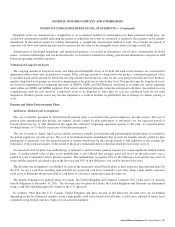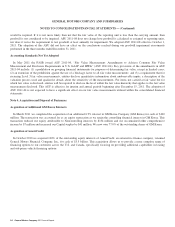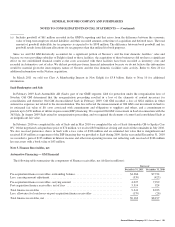General Motors 2011 Annual Report Download - page 91
Download and view the complete annual report
Please find page 91 of the 2011 General Motors annual report below. You can navigate through the pages in the report by either clicking on the pages listed below, or by using the keyword search tool below to find specific information within the annual report.GENERAL MOTORS COMPANY AND SUBSIDIARIES
NOTES TO CONSOLIDATED FINANCIAL STATEMENTS — (Continued)
Agency and Non-Agency Mortgage and Other Asset-Backed Securities
U.S. and foreign government agency mortgage and asset-backed securities, non-agency collateralized mortgage obligations,
commercial mortgage securities, residential mortgage securities and other asset-backed securities are valued based on quotations
received from independent pricing services or from dealers who make markets in such securities. Securities which are priced via the
use of pricing services that utilize matrix pricing which considers readily observable inputs such as prepayment speed assumptions,
attributes of the collateral, yield or price of bonds of comparable quality, coupon, maturity and type as well as dealer supplied prices
are classified in Level 2. Securities within this category that are typically priced by dealers and pricing services via the use of
proprietary pricing models which incorporate significant unobservable inputs are classified in Level 3. These inputs primarily consist
of prepayment curves, discount rates, default assumptions and recovery rates. We may consider other security attributes such as
liquidity, market activity, price level and other factors in assessing the observability of inputs used by pricing services or dealers,
which may affect classification.
Investment Funds, Private Equity and Debt Investments and Real Estate Investments
Investments in exchange traded funds, real estate investment trusts and mutual funds, for which market quotations are generally
readily available, are valued at the last reported sale price, official closing price or publicly available NAV (or its equivalent) on the
primary market or exchange on which they are traded, and are classified in Level 1. Investments in private investment funds
(including hedge funds, private equity funds and real estate funds) are generally valued based on their respective NAV (or its
equivalent), as a practical expedient to estimate fair value due to the absence of readily available market prices. Investments which
may be fully redeemed at NAV in the near-term are generally classified in Level 2. Investments in funds, which may not be fully
redeemed at NAV in the near-term, are generally classified in Level 3.
Investments in private equity, private debt and real estate securities, are generally valued in good faith via the use of the market
approach (earnings multiples from comparable companies) or the income approach (discounted cash flow techniques), and consider
inputs such as revenue growth and gross margin assumptions, discount rates, discounts for lack of liquidity, market capitalization
rates, and the selection of comparable companies. As these valuations incorporate significant unobservable inputs they are classified
as Level 3.
Fair value estimates for private investment funds, private equity, private debt, and real estate investments are provided by the
respective investment sponsors or investment advisers and are subsequently reviewed and approved by management. In the event
management concludes a reported NAV or fair value estimate (collectively, external valuation) does not reflect fair value or is not
determined as of the financial reporting measurement date, we will consider whether an adjustment is necessary. In determining
whether an adjustment to the external valuation is required, we will review material factors that could affect the valuation, such as
changes to the composition or performance of the underlying investment(s) or comparable investments, overall market conditions,
expected sale prices for private investments which are probable of being sold in the short term, and other economic factors that may
possibly have a favorable or unfavorable effect on the reported external valuation. We may adjust the external valuation to ensure fair
value as of the balance sheet date.
Derivatives
Exchange traded derivatives, such as options and futures, for which market quotations are readily available, are valued at the last
reported sale price or official closing price on the primary market or exchange on which they are traded and are classified in Level 1.
Over-the-counter derivatives, including but not limited to swaps, swaptions and forwards, which are typically valued through
independent pricing services with observable inputs are generally classified in Level 2. Derivatives classified in Level 3 are typically
valued via the use of pricing models which incorporate significant unobservable inputs, but may also include derivatives which are
valued with the use of significant observable inputs which are not subject to corroboration. The inputs part of the model based
valuations may include extrapolated or model-derived assumptions such as volatilities and yield and credit spread assumptions.
General Motors Company 2011 Annual Report 89
























